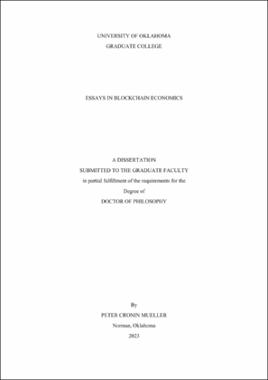| dc.description.abstract | This dissertation consists of three essays (chapters) concerning blockchain economics. Chapter 1 is a study of a decentralized lending platform. Decentralized Financial (DeFi) lending applications allow users to take leveraged positions in risky cryptoassets without the use of a financial intermediary, mimicking the functionality of a margin trading account without a centralized broker. This decentralization comes at a cost; leveraged traders must pay blockchain transaction fees to miners/validators and, absent an intermediary, third parties must be incentivized to perform liquidation transactions on positions with insufficient collateral. I provide evidence suggesting that volatile blockchain transaction fees can effectively “price out” a significant portion of market participants engaged in DeFi leveraged trading, forcing these traders to temporarily abandon their leveraged positions. Meanwhile, I show that the market liquidation incentive disciplines leveraged traders with riskier positions, inducing them to take more conservative positions. These results highlight the limitations of blockchain/DeFi technologies in their current state and have interesting policy implications concerning the regulation of leveraged traders.
Chapter 2 paper provides an empirical overview of the largely unexplored public blockchain ecosystem, coauthored with Felix Irresberger, Kose John, and Fahad Saleh. Our overview highlights that only a few blockchains dominate the ecosystem although no single blockchain, not even Bitcoin, dominates uniformly. We explain our empirical findings with a simple theoretical framework that establishes three key economic attributes - adoption, scale, and security - as the determinants of blockchain user utility. We examine each blockchain along those dimensions empirically. We then theoretically establish that whether a blockchain could be welfare enhancing for some user type can be determined by a comparison across our attributes; in turn, applying the comparison empirically yields that only a few blockchains could be optimal for some user type. Our results thus provide an explanation for why only a few blockchains dominate the broader blockchain ecosystem. Moreover, our work provides an empirical framework from which to evaluate progress within the blockchain ecosystem.
In Chapter 3, I model the entry and exit decisions of cryptocurrency miners. I argue that miners using Application Specific Integrated Circuit (ASIC) equipment, with a lower salvage value, have asymmetric reactions to price shocks, while miners using Graphics Processing Unit (GPU) equipment, with a higher salvage value, have more symmetric reactions to price shocks. Estimating the long-run equilibrium relationship between cryptocurrency price and hashrate (the aggregate computing power of miners), I show that Bitcoin miners, who use ASIC equipment, respond only to negative disequilibria (when hashrate is relatively low compared to price). Meanwhile, Ether miners, when using GPU equipment, respond symmetrically to disequilibria. These results have both practical and theoretical implications for cryptocurrency pricing and applications of blockchain technology. | en_US |
